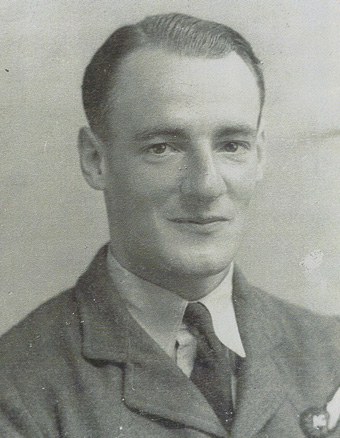[Pic: Alan Kinge]
Sgt A J B Stone
Wireless operator
Lancaster serial number: ED906/G
Call sign: AJ-J
First wave. Fifth aircraft to attack Möhne Dam. Mine dropped accurately, causing large breach. Aircraft returned safely.
Antony Joseph Bazeley Stone was born in Winchester, Hampshire, on 5 December 1920, the younger son of a family of two boys who were the children of Joseph and Dorothy Stone. Born in Russia, from where he emigrated in the 1890s, Joseph Stone was a barber and had a shop in the centre of the city. Stone trained as a chef after leaving school, and had worked at several well known London restaurants before volunteering for the RAF in 1940.
He was selected for wireless operator training, and qualified also as an air gunner. He arrived at 10 OTU at St Eval at the same time as navigator Vivian Nicholson and bomb aimer John Fort, and it is likely that the trio teamed up there, along with gunner Austin Williams and pilot Flt Lt William Elder.
On 5 January 1943, the fledgling crew were transferred to RAF Swinderby, to join 1660 Conversion Unit, where William Hatton and Harold Simmonds were added. On 23 February 1943, the new crew were posted to 207 Squadron to begin operations but after Elder was killed on a ‘second dickey’ trip the crew was transferred to 97 Squadron at Coningsby, and allocated to David Maltby. The whole crew was posted together to 617 Squadron on 25 March 1943.
On the raid, Stone was responsible for starting up the motor which revolved the mine backwards, and checking that it had reached the correct speed of 500rpm before the aircraft started its bombing run.
Four months after the raid, on 14 September 1943, Stone took off from RAF Coningsby on 617 Squadron’s first major operation since the Dams Raid. When their aircraft suffered its final crash it sank with the bodies of all the crew except the pilot, so he has no known grave.
When the news reached his family in Winchester, his mother Dorothy was so shocked she was determined to find out more, and set off by train to Coningsby. She was shown into adjutant Harry Humphries’ office in a state of shock, asking him repeatedly: ‘Did he suffer? Did he suffer?’ She then disarmed Humphries by saying that she was glad that there were brave men like him carrying on the fight. As he noted in his autobiography, sadly, the only battles he fought were against official letters and forms.
Antony Stone left a letter for his parents, only to be opened on the event of his death. A fragment of it survives in a typescript version in the possession of the Maltby family:
I will have ended happily, so have no fears of how I ended as I have the finest crowd of fellows with me, and if Skipper goes I will be glad to go with him. He has so much more to lose and more responsibilities than I and you can rest assured and know that I’ve taken hundreds with me who lived as you do and never even gloried in the war as I did and I still experience that same thrill every time I fly.
His father kept his photograph in his shop until the day he retired, and it is still recalled by generations of boys and men who had their hair cut by him.
Antony Stone is commemorated on the Runnymede Memorial.
More about Stone online:
Commonwealth War Graves Commission
Breaking the Dams website
KIA 15 September 1943.
Rank and decorations as of 16 May 1943.
Sources: Charles Foster, Breaking the Dams, Pen and Sword 2008
Richard Morris, Guy Gibson, Penguin 1995
John Sweetman, The Dambusters Raid, Cassell 2002
 Further information about Antony Stone and the other 132 men who flew on the Dams Raid can be found in my book The Complete Dambusters, published by History Press in 2018.
Further information about Antony Stone and the other 132 men who flew on the Dams Raid can be found in my book The Complete Dambusters, published by History Press in 2018.
